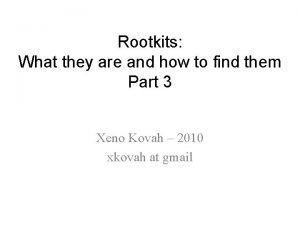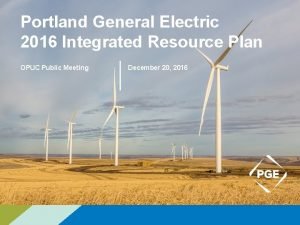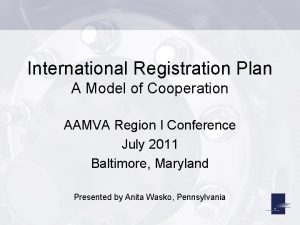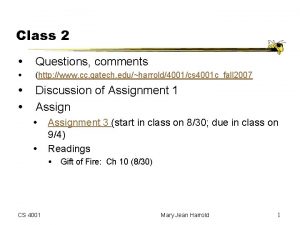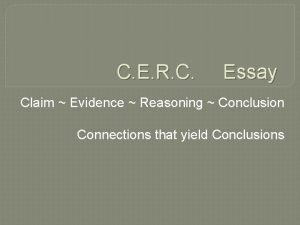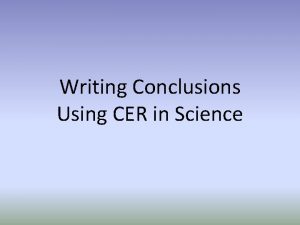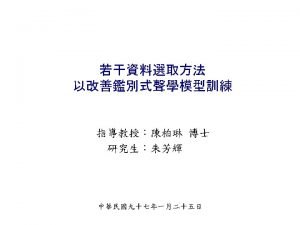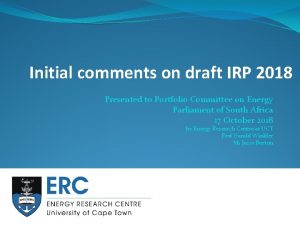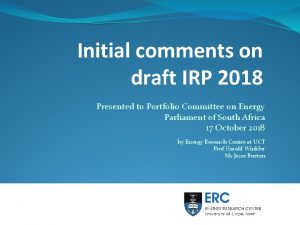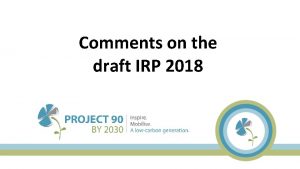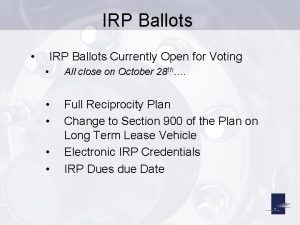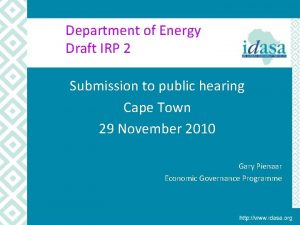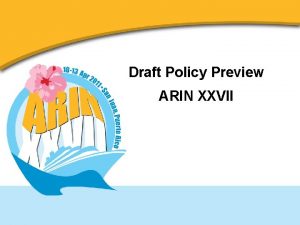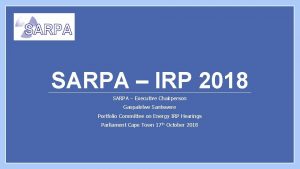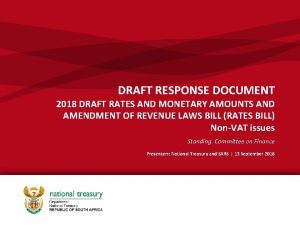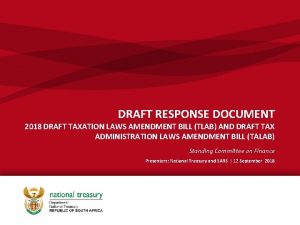CER Comments on the Draft IRP 2018 COMMENTS


















![CER Comments on the Draft IRP 2018 Urgent need to address climate crisis “[E]ven CER Comments on the Draft IRP 2018 Urgent need to address climate crisis “[E]ven](https://slidetodoc.com/presentation_image_h/b3daceb6b768e3827185ebce65c58d00/image-19.jpg)








- Slides: 27

CER Comments on the Draft IRP 2018 COMMENTS ON THE DRAFT IRP 2018 Parliamentary Portfolio Committee on Energy 16 October 2018 Robyn Hugo and Nicole Loser

CER Comments on the Draft IRP 2018 Who we are We are activist lawyers who help communities and civil society organisations in South Africa realise our Constitutional right to a healthy environment by advocating and litigating for environmental justice. The Life After Coal Campaign aims to: discourage the development of new coal-fired power stations and mines; reduce emissions from existing coal infrastructure and encourage a coal phase-out; and enable a just transition to sustainable energy systems for the people. 1

CER Comments on the Draft IRP 2018 Legal requirements for the IRP • The Constitution of RSA • Section 24: everyone has the right to an environment that is not harmful to health or well-being; and to have the environment protected, for the benefit of present and future generations. The state has a duty to take reasonable legislative and other measures to give effect to that right. • The Electricity Regulation Act • The IRP is “a resource plan established by the national sphere of government to give effect to national policy. ” 2

CER Comments on the Draft IRP 2018 Objections to the draft IRP 2018 • the inclusion of 1000 MW of unnecessary and harmful new coal capacity; • the arbitrary and unreasonable annual constraint on renewable energy (RE) capacity until 2030; • the failure to give adequate (or in most cases any) consideration to the external costs and impacts of various electricity sources for water, health, ecosystems, and climate; 3

CER Comments on the Draft IRP 2018 Objections to the draft IRP 2018 (cont. ) • the failure to adequately convey the urgency and need to rapidly transition from fossil fuels and to eliminate greenhouse gas (GHG) emissions from the electricity sector; • the assumption of 50 year lives for all Eskom stations, rather than the period for which each remains economic, is necessary for energy security, and can comply with the law (remaining units of the very-delayed and over-budget Medupi and Kusile power stations should also be abandoned); 4

CER Comments on the Draft IRP 2018 Objections to the draft IRP 2018 (cont. ) • the extensive provision for new gas capacity, without clarity on, inter alia, the sources of gas or evaluating competing, increasinglycheaper and fast-developing alternatives such as battery storage and demand-side options to address peak demand; • the failure to use accurate and realistic assumptions for: demand projections (inflated in the IRP), technology costs, and the rapidlychanging energy landscape; and 5

CER Comments on the Draft IRP 2018 Objections to the draft IRP 2018 (cont. ) • the failure to conduct adequate consultations and participation with affected communities and to provide stakeholders with the modelling data, crucial for effective and meaningful consideration of and participation. 6

CER Comments on the Draft IRP 2018 Challenging 1 000 MW New Coal in the IRP • Thabametsi (557 MW) – Lephalale, Limpopo, & Waterberg-Bojanala Air Quality Priority Area; and • Khanyisa (306 MW) – e. Malahleni, Mpumalanga, & Highveld Air Quality Priority Area. 7

CER Comments on the Draft IRP 2018 Harmful impacts of coal & the Coal IPPs • Air pollution • Water usage and pollution • Climate change impacts • “GHG-intensity of the coal IPPs [is] much higher than the world average. The GHG-intensity is approximately 24% higher than the current Eskom fleet average and 58% higher than Medupi & Kusile” – ERC, 2018 • Failure to consider externalities 8

CER Comments on the Draft IRP 2018 Harmful impacts of coal & the coal IPPs (cont. ) • Costs • “In the reference scenario, the additional present value cost of building the coal IPPs is R 19. 68 billion … even with pessimistic renewable energy cost projections and high gas costs, the coal IPPs still increase the system costs in the electricity sector compared to an optimised electricity build plan” – ERC, 2018. 9

CER Comments on the Draft IRP 2018 Harmful impacts of coal & the Coal IPPs (cont. ) • “[n]ot only are the coal IPPs not required to meet demand, and not only do they raise costs, and increase emissions, but they also result in increasing pressure on Eskom. Building new coal plants in a situation of low demand means reducing the output of Eskom’s fleet, potentially accelerating the ‘utility death spiral’ in which Eskom already finds itself and putting the electricity supply industry – and thus the South African economy – at risk” (emphasis added) – ERC, 2018. • “Eskom is facing a financial crisis and rising electricity prices will drive consumers away from the utility” - ERC, 2018. 10

CER Comments on the Draft IRP 2018: Recommended Plan (p 39): 11

CER Comments on the Draft IRP 2018 Coal IPPs not “procured” or committed • • Do. E within rights to withdraw or terminate Coal IPP Programme at any time. Legal challenges of authorisations pending (including High Court review applications). Necessary licences outstanding. Various Electricity Regulation Act (ERA) and Public Finance Management Act steps and approvals still outstanding before power purchase agreements (PPAs) can be signed. 12

CER Comments on the Draft IRP 2018 Coal IPPs not “procured” or committed (cont. ) • Regulation 9, Regulations for New Generation Capacity, ERA: “(1) A power purchase agreement between the buyer and an IPP must meet the following requirements – (a) value for money; (b) appropriate technical, operational and financial risk transfer to the generator; (c) effective mechanisms for implementation, management, enforcement and monitoring of the power purchase agreement; and (d) satisfactory due diligence in respect of the buyer's representative and the proposed generator in relation to matters of their respective competence and capacity to enter into the power purchase agreement” (emphasis added). 13

CER Comments on the Draft IRP 2018 “Value for money”: • “that the new generation capacity project results in a net benefit to the prospective buyer or to Government having regard to cost, price, quality, quantity, risk transfer or a combination thereof, but also where applicable to the Government's policies in support of renewable energy” (emphasis added) – New Generation Regulations, ERA • “outcome of the consideration as to whether or not a project delivers value for money, is required to produce an assessment that the project is in the best interests of and delivers an acceptable outcome to the buyer (Eskom) and the Government acting on behalf of and in the best interests of the people of South Africa, including electricity users” (emphasis added) – Request for Proposals, CBIPPP 14

CER Comments on the Draft IRP 2018 Jobs & a Just Coal Transition • The transition is inevitable and underway. • There will be further job losses in the coal sector, unless government puts in place credible, well-communicated, and expertly-executed plans to support workers, and diversify the economy towards labourintensive sectors. • “Unless credible plans to support workers at coal plants and communities in coal areas are put in place, achievement of the NDC will elude South Africa”. https: //coaltransitions. org/ 15

CER Comments on the Draft IRP 2018 Jobs & a Just Coal Transition (cont. ) • “Coal transitions are affordable for energy consumers because the transition away from coal is now the least-cost option for South Africa”. • “Even without any climate policy impacts, the closures of power plants are inevitable, and worker retraining, reskilling, and regional development initiatives are required to ease the transition”. 16

CER Comments on the Draft IRP 2018 Jobs & a Just Coal Transition (cont. ) • Existing and potential jobs in the RE sector – which could also be located in mining areas - should be recognised and supported. • Do. E’s own study finds that 30% more permanent direct jobs per unit of energy are created with the RE mix than with coal. • Solar PV and wind are more job-intensive along the entire value chain, and also more resilient, than coal-fired power stations jobs. • Legally-required decommissioning of Eskom’s power plants, and rehabilitation of coal mines and land impacted by coal mining, would result in extensive employment opportunities, particularly for ex-mine and power station workers. 17
![CER Comments on the Draft IRP 2018 Urgent need to address climate crisis Even CER Comments on the Draft IRP 2018 Urgent need to address climate crisis “[E]ven](https://slidetodoc.com/presentation_image_h/b3daceb6b768e3827185ebce65c58d00/image-19.jpg)
CER Comments on the Draft IRP 2018 Urgent need to address climate crisis “[E]ven under emission scenarios that are more conservative than current international emission trends, it has been predicted that by mid-century the South African coast will warm by around 1 to 2°C and the interior by around 2 to 3°C. By 2100, warming is projected to reach around 3 to 4°C along the coast, and 6 to 7°C in the interior. With such temperature increases, life as we know it will change completely: parts of the country will be much drier and increased evaporation will ensure an overall decrease in water availability. This will significantly affect human health, agriculture, other water-intensive economic sectors such as the mining and electricity-generation sectors as well as the environment in general. Increased occurrence and severity of veld and forest fires; extreme weather events; and floods and droughts will also have significant impacts” (emphasis added) – SA Climate Change Response White Paper, p 9. 18

CER Comments on the Draft IRP 2018 Urgent need to address climate crisis (cont. ) • A significant portion of SA’s electricity still derived from fossil fuels by 2030 (6 732 MW of new coal and 8 100 MW of new gas/diesel capacity) • https: //climateactiontracker. org/countries/south-africa/ 19

CER Comments on the Draft IRP 2018 Urgent need to address climate crisis (cont. ) • Intergovernmental Panel on Climate Change on Global Warming of 1. 5 °C, October 2018 • human activities have already caused approximately 1. 0°C of global warming above pre-industrial levels, resulting in increased natural disasters, droughts, and rising sea levels 20

CER Comments on the Draft IRP 2018 Urgent need to address climate crisis (cont. ) • IPCC Report on Global Warming of 1. 5 °C: • • There are limits to adaptive capacity for some human and natural systems at 1. 5°C - limiting global warming to 1. 5°C would require “rapid and far-reaching” transitions in land, energy, industry, buildings, transport, and cities Global net human-caused emissions of carbon dioxide (CO 2) must fall by about 45 % from 2010 levels by 2030, reaching ‘net zero’ around 2050 21

CER Comments on the Draft IRP 2018 Urgent need to address climate crisis (cont. ) • What does the IPCC Report means for us? • • South Africans and our future generations are exposed to irreversible devastating climate change impacts; and drastic interventions are required now to avoid this. • Our Constitution demands that more urgent, bolder steps be taken. • The State of the Netherlands v the Urgenda Foundation, October 2018 22

CER Comments on the Draft IRP 2018 State of the Netherlands v the Urgenda Foundation • “the State has a positive obligation to protect the lives of citizens within its jurisdiction …. This obligation applies to all activities, public and non-public, which could endanger the rights protected …, and certainly in the face of industrial activities which by their very nature are dangerous” (para 43) • “the Court believes that it is appropriate to speak of a real threat of dangerous climate change, resulting in the serious risk that the current generation of citizens will be confronted with loss of life and/or a disruption of family life. …. . [T]he State has a duty to protect against this real threat”(para 45) 23

CER Comments on the Draft IRP 2018 State of the Netherlands v the Urgenda Foundation (cont. ) • “up till now the State has done too little to prevent a dangerous climate change and is doing too little to catch up, or at least in the short term (up to end-2020). Targets for 2030 and beyond do not take away from the fact that a dangerous situation is imminent, which requires interventions being taken now. In addition to the risks in that context, the social costs also come into play. The later actions are taken to reduce, the quicker the available carbon budget will diminish, which in turn would require taking considerably more ambitious measures at a later stage… to eventually achieve the desired level of 95% reduction by 2050” (para 71) 24

CER Comments on the Draft IRP 2018 Conclusion • An urgent and inclusive just transition away from coal is in the public interest and it is the least-cost option. • We need to abandon unnecessary new coal and expedite the decommissioning of our ageing coal fleet. • We can decarbonise the electricity sector relatively easily and affordably and it comes with the added co-benefits for human health, water, and improving access to clean and affordable electricity. • A final IRP that includes new coal-fired power plants is unconstitutional, and will be met with legal challenge. 25

CER Comments on the Draft IRP 2018 +27 21 447 1647 info@cer. org. za www. cer. org. za /Centre. Environmental. Rights @Centre. Env. Rights
 Objective of draw frame
Objective of draw frame Irp hook
Irp hook Nida irp
Nida irp Irp 24
Irp 24 Portland general electric irp
Portland general electric irp Aamva international conference
Aamva international conference Interest rate parity
Interest rate parity Cyber disaster planning
Cyber disaster planning Irp commerce
Irp commerce Setprocesspriorityboost
Setprocesspriorityboost Nysed irp
Nysed irp Gatech cs 4001
Gatech cs 4001 Acalasia classificazione di chicago
Acalasia classificazione di chicago B a f c j e
B a f c j e Motive literare sara pe deal
Motive literare sara pe deal Cer sorting company
Cer sorting company Cerc paragraph example
Cerc paragraph example La tine vin si imi cer iertare
La tine vin si imi cer iertare Queenie slip or trip
Queenie slip or trip Cer sentence starters
Cer sentence starters Cell theory cer
Cell theory cer Claim evidence reasoning example
Claim evidence reasoning example Reasoning sentence starters
Reasoning sentence starters Examples of reasoning in cer
Examples of reasoning in cer Cer conclusion
Cer conclusion Shamwow cer
Shamwow cer Dis de dimineata-n zori varsa lacrimi peste flori
Dis de dimineata-n zori varsa lacrimi peste flori Cermmi
Cermmi

